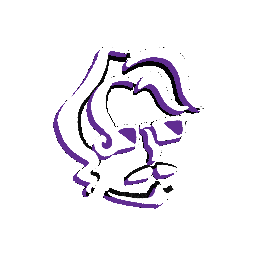

"Skateboard Ninja is radical 2.5D platformer, where you'll need all your ninja skills and skateboard tricks to slash & dash your way through mythical Yokai in feudal Japan"
Skateboard Ninja was a one-semester project in my traditional game dev class. Developed during the COVID-19 pandemic, the team was entirely remote. Between the pandemic and our short development time, production was uniquely challenging. I took every opportunity to help the team deliver the project, whether I was maintaining the HackNPlan or filling in for sick teammates.

Unreal 4, Adobe Suite, HackNPlan

4 Months

6-Person Team

Producer, Generalist
As the producer, my primary responsibility was managing inter-team communication and assigning tasks while managing our timelines. It is an enormous credit to everyone on the team that this was the easiest part of work on Skateboard Ninja, and I more often worked as a facilitator and translator between the distinct art and engineering teams.
During development, we used HacknPlan to manage dependencies and task assignments. I also occasionally took on the duties of verifying and testing the new assets we were creating. This mainly included managing our version control and making sure any new assets wouldn't conflict with older ones.
As the project moved along and I became more familiar with the responsilibilies of a producer, I also ended up pulling some weight as the director. As deadlines approached, I started to lay out more specific visions and directions for the art team in particular, in order to give the game a cohesive and appealing aesthetic.
The character design for the Ninja was one of our first stumbling blocks. What we ended up using was roughly inspired by some shape language explorations I did early in the project. The Ninja is made of all curved and flowing lines, in order to better contrast with the rigid background and enemies. To give the Ninja a rougish, agile appearnce, his basic shapes are two long, wavy triangles laid on top of one another.
Shortly after the preproduction ended, our lead artist had to leave the project for personal reasons. The remaining artists didn't have experience with animation and already had a lot on their plate, so I drew and animated the Ninja's movements in Adobe Illustrator. I exported each fram as an artboard and imported these into Unreal to assemble at runtime.
By the end of the project, we were shifting responsibilities rapidly. One of our artists had designed fun level layouts, so during the last couple weeks of development I went through and started putting the art team's hard work to use and filling the levels with clutter and visual interest.
Outside of my experience in a production role, this might be the part of the game I was most proud of (and took the most time conceptualizing, refining, and communicating). In an early build, our professor gave us feedback to start building our levels in larger chunks, so that it wouldn't take so long to build out levels from the rough shapes we were using at the time. Unbeknownst to him, we had already been doing that, and I took this as all I needed to start desiging a modular drag-and-drop level design format.
I spent the next few weeks desiging this in the background, while the other rough assets and programming was being done. My goal was to break the level down into as few shapes as possible, so that they could be copied and pasted in a grid to quickly build out a variety of levels. After much deliberation and a lot of napkin drawings, I had three shapes that could be used to make every level we could dream of. Our art team quickly turned these assets into reality, and aside from some version control troubles, we were ready to roll and had new levels being built quite literally overnight.
The sweeping camera movement was my favorite little pet project. We didn't need to have a dynamic camera that adjusted it's location based on player velocity, but it does help to sell the sense of motion, and it is very cool. I started working on it during the alpha phases, while we were trying to find a way to show more of the map, while still having a camera close to the character, and showing off the art team's models. I can't thank the engineering team enough for reeling me in and helping to turn a nauseating camera swing into a subtle and fun perspective shift.
The Kappas were interesting because their programming was never intended to make it past the alpha. By the time we had reached that point, though, the engineering team started to really dig into the movement mechanics, and someone had to pick up the slack. I built a rough enemy program that would walk back and forth, and charge at the player when they got near. This program, polished up by the engineering team and myself, is essentially what shipped in the final version of the game.
As I was the one making the animations, I was the most familiar with how they needed to be implemented. With the help of the engineering team, I built a simple animation state machine that would check a variety of variables in order to choose the correct frames for every action the player could perform.
The logo is one place I wish we could've spent more time, but there were far, far more important tasks to finish throughout the entire project. I tossed a rough design together in illustrator, and one of the artists commented that it looked like a skateboard and a ninja wearing a headband at the same time. I leaned into that, and after a few more iterations, we had our logo.
The above wrap sheet was part of the wrap kit I assembled for the project. This included the video made by Trek Rhodehouse, as well as a variety of screenshots and press materials. The wrap sheet was designed with inDesign, and very tangentially drew inspiration from the box art and design for Tony Hawk: Pro Skater.
In such a creative field, it can be difficult to unite every team member on a project under one vision, especially when the team could not meet in-person and was made up of students from various levels of experience. Regardless, the Lucky Ninja team in my Spring 2022 Traditional Games class came together to make a game we're all proud of. I attribute much of this success to SBN's extended preproduction period, during which we disobeyed the professor's instructions and rather than compete with our unique pitches, combined them into something new. Because everyone had a say in the game's concept and design, it meant that everyone on the team was deeply invested in the success of our project.
When we started work on SBN, I didn't know what to expect from a production role on a small team. Most of my other projects to this point had been individual efforts or game jam teams with no need for producers. In order to ship SBN's alpha build, I had to take over some of the tasks that others on the team were unable to complete, and by taking on these other hats, I facilitated my teammates in focusing on the tasks they were more personally excited for. It was this job, of helping my team achieve things they hadn't anticipated from themselves, that highlighted to me why I wanted to produce games.
When an pushing accident broke all of our levels, I've never been more relieved for Perforce's rollback features. This project taught me a lot about the value and the technical operation of version control.
The teamwork and collaboration on Lucky Ninja was second-to-none, and it was a blast seeing ideas transform and respond to the needs of individuals on a small indie team.
I have fond memories of calling in from hotel rooms and coffee shops to collaborate with my teammates on this project. The work-from-home nature of the pandemic meant that there was always something new!
